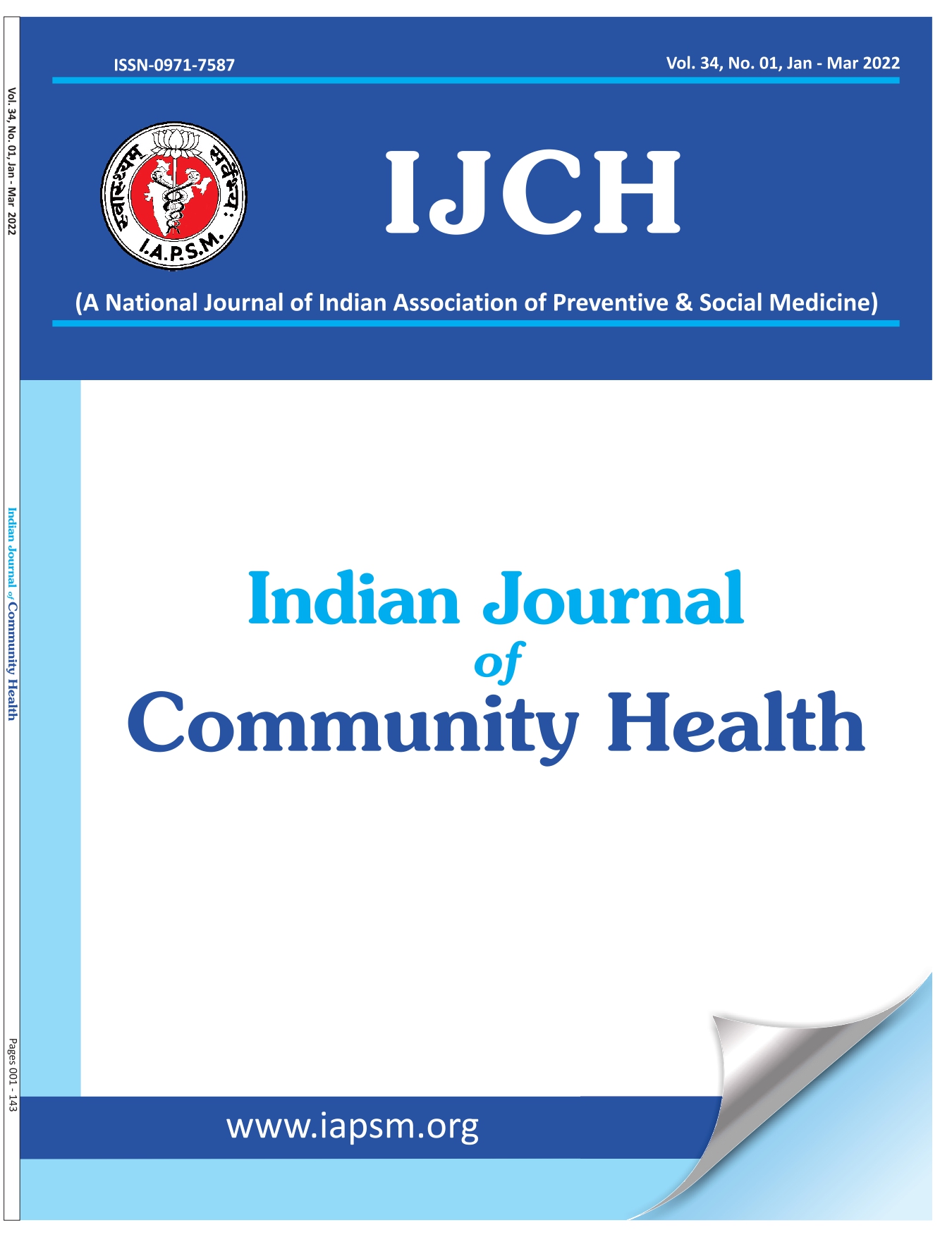Designing and Validating a Multimorbidity Assessment Questionnaire for a Rural Indian Community
DOI:
https://doi.org/10.47203/IJCH.2025.v37i01.028Keywords:
Multimorbidity, Rural, Oral Health, Community, QuestionnaireAbstract
Introduction: Multimorbidity, has received its undue attention in the recent years, because of its hidden impact on the patients and their families, especially in environments with little resources. There is no data available on the prevalence of multimorbidity (for both oral and systemic) in Uttarakhand to the best of our knowledge. The aim of this study is to develop a multimorbidity questionnaire in a rural Indian community. Methods: The pilot study was conducted in Kurkawala, Dehradun, Uttarakhand, India in February 2023. Results: Our sample had mean age of 46 years, with 54.2% females. 88.5 % of the participants were found to be with any morbidity, whereas 31.5% participants were found to be with only oral morbidity. 57.9% participants were found with Oral Morbidities along with One systemic Morbidity followed by 21.1% participants with Oral Morbidities along with Two systemic Morbidities. 25.8% participants were found to have with both Hypertension and Oral Conditions, followed by Acid peptic disease and Any Chronic Bone/Joint Disease; Any Neurological and/or Psychiatric Disorders (19.4% respectively). Discussion: Developing a stronger evidence base of the knowledge of risk factors and their determinants as well as implementing proven effective strategies (both at individual as well as societal level) for multimorbidity risk reduction hold the key to lower multimorbidity burden and improve quality of life globally. Conclusion: Our findings show that this questionnaire is a reliable and trustworthy way to assess multimorbidity in a community setting with a range of chronic illnesses (both systemic and oral).
Downloads
References
Multimorbidity Technical Series on Safer Primary Care Multimorbidity: Technical Series on Safer Primary Care. 2016. https://www.who.int/publications/i/item/9789241511650 (Accessed on 25 Feb 2025)
Tugwell P, Knottnerus JA. Multimorbidity and Comorbidity are now separate MESH headings. J Clin Epidemiol. 2019;105:vi–viii.
Violan C, Foguet-Boreu Q, Flores-Mateo G, Salisbury C, Blom J, Freitag M, Glynn L, Muth C, Valderas JM. Prevalence, determinants and patterns of multimorbidity in primary care: a systematic review of observational studies. PLoS One. 2014 Jul 21;9(7):e102149
Fortin M, et al. A Systematic Review of Prevalence Studies on Multimorbidity: Toward a More Uniform Approach. Ann Fam Med.2021;10(2),142–151.
Prenissl J, De Neve J-W, Sudharsanan N, Manne-Goehler J, Mohan V, Awasthi A, et al. Patterns of multimorbidity in India: A nationally representative cross-sectional study of individuals aged 15 to 49 years. PLOS Glob Public Health.2022;2(8): e0000587.
Skou ST, Mair FS, Fortin M, Guthrie B, Nunes BP, Miranda JJ, et al. Multimorbidity. Nat Rev Dis Primers. 2022;8(1):48.
Watt RG, Serban S. Multimorbidity: a challenge and opportunity for the dental profession. Br Dent J. 2020 Sep 1;229(5):282.
Multimorbidity- A major health challenge of 21st century. The George Institute for Global Health. 2024. Available from: https://www.georgeinstitute.org.in/philanthropic-opportunities/multimorbidity-a-major-health-challenge-of-21st-century (Accessed on 25 Feb 2025)
Sinha A, Kerketta S, Ghosal S, Kanungo S, Pati S. Multimorbidity Among Urban Poor in India: Findings From LASI, Wave-1. Front Public Health. 2022 Jun 2;10:881967.
Ghosal S, Sinha A, Kerketta S, Acharya AS, Kanungo S, Pati S. Oral health among adults aged ?45 years in India: Exploring prevalence, correlates and patterns of oral morbidity from LASI wave-1. Clin Epidemiol Glob Health. 2022; 18:101177.
International Institute for Population Science. National Family Health Survey:Questionnaire. Available from: https://rchiips.org/nfhs/ (Accessed on 25 Feb 2025)
World Health Organisation. Standard STEPS Instrument. Available from: https://www.who.int/publications/m/item/standard-steps-instrument (Accessed on 25 Feb 2025)
World Health Organisation. Global physical activity questionnaire (GPAQ). Available from: https://www.who.int/publications/m/item/global-physical-activity-questionnaire (Accessed on 25 Feb 2025)
Petersen, Poul Erik, Baez, Ramon J & World Health Organization. Oral health surveys: basic methods, 5th ed. World Health Organization. 2013. Available from: https://iris.who.int/handle/10665/97035 . (Accessed on 25 Feb 2025)
International Institute for Population Sciences (IIPS). Longitudinal Ageing Study in India (LASI). Available from: https://www.iipsindia.ac.in/lasi (Accessed on 25 Feb 2025)
Agborsangaya CB, Lau D, Lahtinen M, Cooke T, Johnson JA. Multimorbidity prevalence and patterns across socioeconomic determinants: a cross-sectional survey. BMC Public Health. 2012 ;12:201
Wolf TG, Cagetti MG, Fisher JM, Seeberger GK, Campus G. Non-communicable Diseases and Oral Health: An Overview. Frontiers in Oral Health. 2021;2:725460.
Academy Of Medical Sciences. Multimorbidity: a priority for global health research. 2018. Available from: https://acmedsci.ac.uk/file-download/82222577 (Accessed on 25 Feb 2025)
Chowdhury SR, Chandra Das D, Sunna TC, Beyene J, Hossain A. Global and regional prevalence of multimorbidity in the adult population in community settings: a systematic review and meta-analysis. EClinicalMedicine. 2023;57:101860.
Varanasi R, Sinha A, Bhatia M, Nayak D, Manchanda RK, Janardhanan R, Lee JT, Tandon S, Pati S. Epidemiology and impact of chronic disease multimorbidity in India: a systematic review and meta-analysis. J Multimorb Comorb. 2024; 14:26335565241258851.
Downloads
Published
How to Cite
License
Copyright (c) 2025 Deepti Nagrath, Jayanti Semwal , Rajeev Mohan Kaushik

This work is licensed under a Creative Commons Attribution-NonCommercial-NoDerivatives 4.0 International License.





